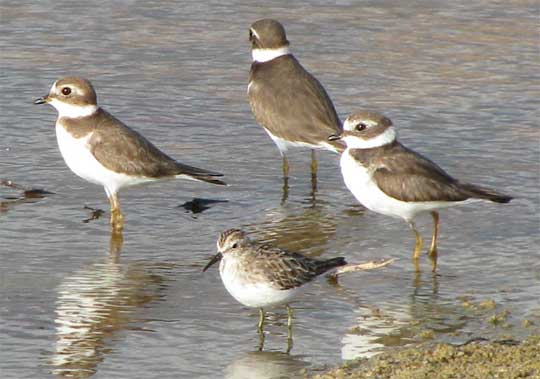Excerpts from Jim Conrad's
Naturalist Newsletter
from the December 15, 2008 Newsletter written at Mayan Beach Garden Resort 20 kms north of Mahahual; Caribbean coastal beach and mangroves, ~N18.89°, ~W87.64°, Quintana Roo state, MÉXICO
SEMIPALMATED PLOVERS
At a spot down the beach a landowner has scalped the vegetation so far from the road that he's created open water with a shallowly sloping mudflat where once dense mangrove stood. Of course that's obliterated species-rich mangrove ecology there but it's also provided a nice place for small wading birds not interested in the sandy beaches right across the rise.

Above you see part of a small flock encountered there about an hour after sunrise last Wednesday morning. Wind off the ocean was tremendous and the birds were just standing there basking in the sunlight and leaning into the wind.
The three larger birds with white necklaces are Semipalmated Plovers, CHARADRIUS SEMIPALMATUS, who nest along the northernmost coasts of Arctic North America, but overwinter from the coastal southeastern US south to Chile and Argentina. They're so commonly seen over this huge winter distribution that it's hard to imagine what their population density must be during their brief breeding period in the Arctic.
If you're an inlander North American you might notice the Semipalmated Plover's similarity to North America's Killdeer. They're in the same genus. You'll remember that Killdeer wear white necklaces, too.
The smaller bird up front looks a lot like one of the Sanderlings that that morning were busily foraging on the sandy beach just over the rise from the mudflat, but Sanderlings, as noted last week, generally occur in small flocks on the beach chasing waves in and out. Several small wader species in winter plumage have the Sanderling look and they can be awfully hard to separate in the field. I wouldn't be able to identify it myself, but my friend David Wingate, master of the birds of Bermuda, assures me that it's a Least Sandpiper. "You can distinguish it by its slightly down-turned bill and yellowish legs," he writes.